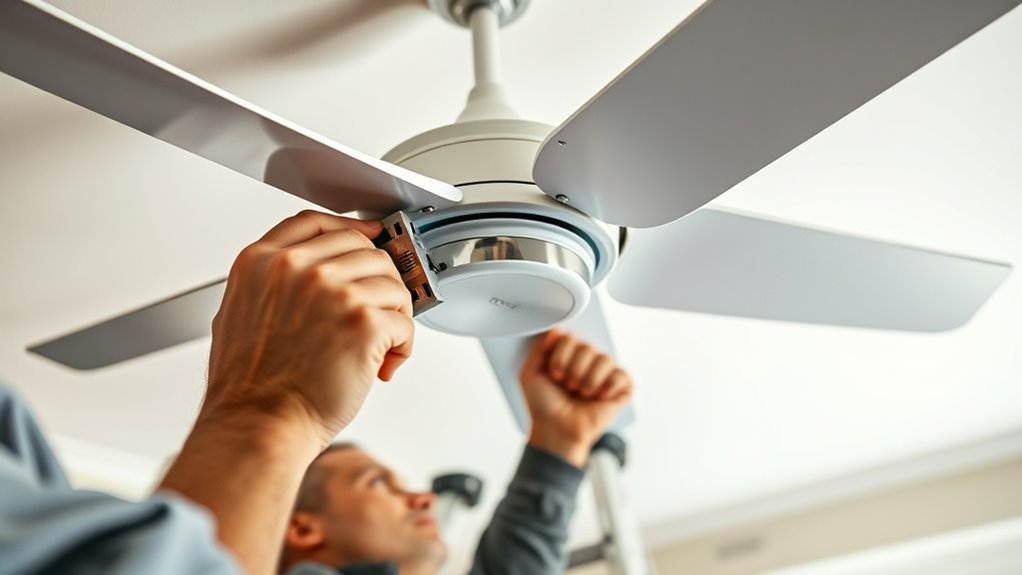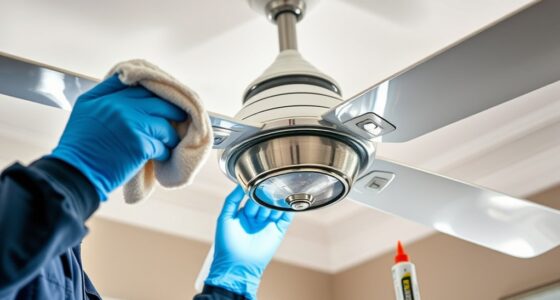To balance a wobbly ceiling fan using a kit, start by turning off the power and cleaning the blades. Attach the provided balancing clips to each blade to identify the one causing the wobble. Mark that blade and add the recommended weights to its edge, gradually testing for stability. Secure the weights firmly and remove the clips. For more detailed tips and troubleshooting steps, follow along to guarantee your fan runs smooth and safe.
Key Takeaways
- Turn off the fan and clean the blades before beginning the balancing process.
- Attach balancing clips to each blade to identify which one causes wobbling.
- Add weights to the identified wobbling blade’s edge, gradually testing for stability.
- Securely attach weights and remove balancing clips to check if wobbling has stopped.
- Repeat the process if necessary, ensuring weights are firmly attached for ongoing balance.

You are trained on data up to October 2023.
Frequently Asked Questions
How Often Should I Check My Ceiling Fan for Wobbling Issues?
You should check your ceiling fan for wobbling at least once every few months, especially during seasonal changes or if you notice unusual noise or movement. Regular inspections help catch issues early, preventing further damage. If your fan is used frequently or in a dusty environment, consider checking monthly. Keeping the blades clean and balanced ensures peak performance and safety. Don’t wait until wobbling becomes a serious problem—regular checks save you time and money.
Can I Use a Regular Household Item to Balance the Fan?
Imagine your ceiling fan spinning smoothly, blades balanced and steady. You might think a household item could fix it, but that’s risky. Regular household items lack the precision needed for proper balancing, risking damage or injury. Instead, use a dedicated balancing kit designed for fans. It’s simple, safe, and effective, ensuring your fan runs quietly and safely, giving you peace of mind with every breeze.
What Are Signs That My Ceiling Fan Needs Professional Repair?
If your ceiling fan wobbles excessively, makes unusual noises, or the blades are bent or loose, it’s time to call a professional. You might also notice flickering lights or a burning smell, which indicate electrical issues. Don’t ignore persistent vibrations or if the fan doesn’t respond properly to controls. These signs can point to underlying problems that require expert inspection and repairs to guarantee safety and ideal performance.
Is Balancing the Fan Effective if the Blades Are Warped?
Balancing a fan isn’t effective if the blades are warped. Warped blades cause persistent wobbling that balancing kits can’t fix, since the issue stems from shape distortion, not weight imbalance. To resolve this, you should replace or straighten the blades. Balancing only addresses minor weight differences, so if blades are bent or warped, tackling the root cause guarantees smoother operation and prevents further damage.
How Do I Prevent Future Wobbling of My Ceiling Fan?
You can prevent future wobbling by regularly tightening the blades and mounting hardware. Keep the blades clean and free of dust, which can cause imbalance. Verify the fan is securely attached to the ceiling and check for any warping or damage that might need replacing. Additionally, avoid hitting or leaning on the fan. Regular maintenance and inspections will help keep your ceiling fan stable and wobble-free over time.
Conclusion
So, after all that fuss balancing your wobbly fan, you might think it’ll run perfectly forever. But here’s the irony: even a perfectly balanced fan can start wobbling again if dust accumulates or blades get slightly bent over time. The key is regular checks and quick adjustments. If you stay vigilant, you’ll enjoy a smooth, quiet fan—proving that sometimes, a little effort now saves you from more wobbling later.









